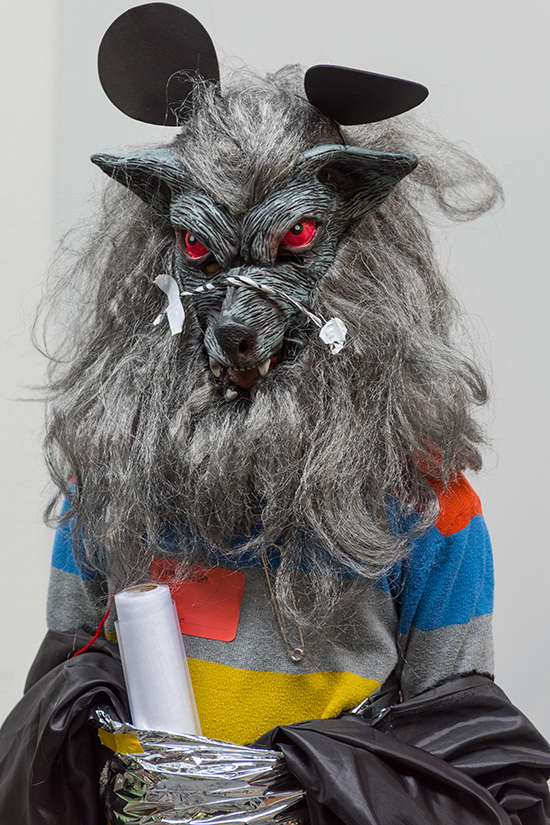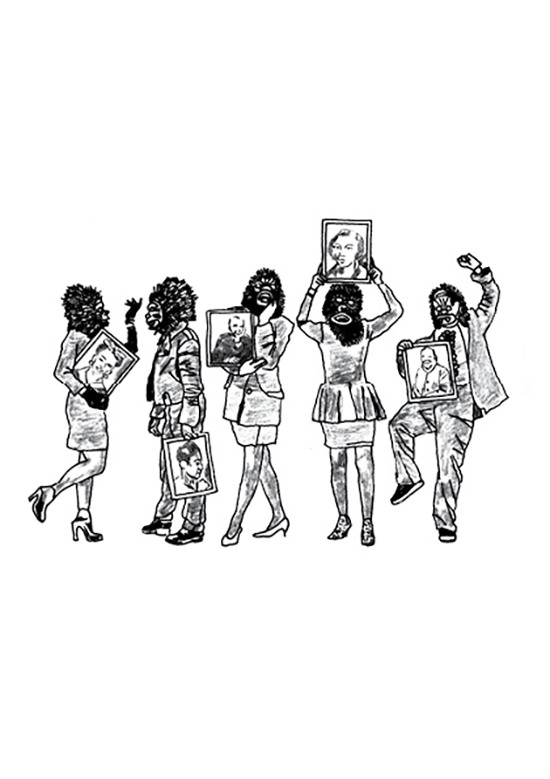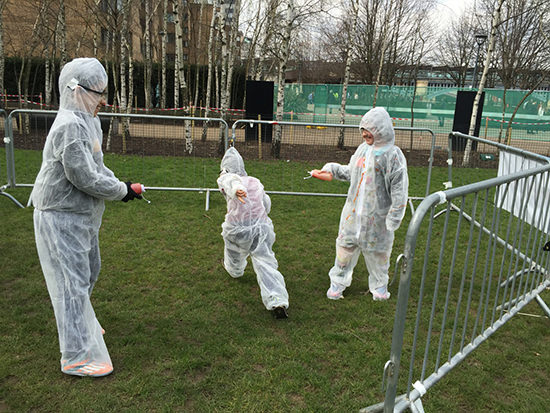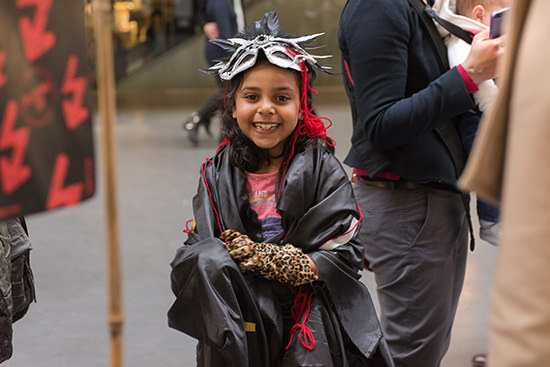Playing the live art game
Madeleine Hodge: PLAYING UP, Live Art for Kids and Adults

Participant, Playing Up (Lone Twin’s Beastie)
photo Seraphina Neville, Tate Photography
Participant, Playing Up (Lone Twin’s Beastie)
Walking through the Turbine Hall, you notice that the Tate Modern feels different this weekend. Loud, not unhappy screaming is heard in the distance, dads sprawl on cushions with children draped across their laps, families sit on floors as though at a music festival, people are gathered in groups strategising, plotting and scheming.
At first glance you can see a different set of permissions is being performed, there is mess, dressing up, wearing masks and holding signs. You can’t help noticing the way play inhabits the body; it’s like an irrepressible force erupting within the tired old halls of the museum. As you wander the landing of the Turbine Hall finding a mum dressed as a Lone Twin Beastie (2010), children Freeing the Voice (after Marina Abramovic, 1976), tiny Guerilla Girls campaigning for less chilli and more ice cream, these live art works intersect and grind against one another.
Taking place over three days in the Turbine Hall, Playing Up launched a live art education project of the same name—a game designed by Sybille Peters of Hamburg’s Theatre of Research. Thirty-six live art projects are presented on cards via illustration and description with instructions for participants to re-perform these artworks.
We queue up to join the game and are asked to invent a live art name for ourselves. In our group we had peter(pizza), big bird, spaghetti, metal and an image of a horse. Students from Wapping High School enjoy telling us what to do and leading us through the simple process of choosing a card from the deck. There are six subject headings: Beings and Things, Dare and Danger, Science and Tinkering, Body and Perception, Memories and Collections and Out and About. We choose Dare and Danger (of course!). Handed a large card on the back of which is Santiago Sierra’s Person Saying a Phrase (2002), we are directed to another area to collect our materials, including a small pile of change (£1.57), a piece of paper and a pencil. The game has begun.
The game involves inventing a phrase about money and then paying someone to say it. We come up with a sentence, deciding on having them say to us, “You don’t have very much money but I earn (fill in the blank) per year.” We think this pretty much nails the challenge and we set off to find people to take our change. Our first participant is very agreeable, letting us film him making an impassioned plea for people to give money to homeless people. He tells us he is unemployed, but is very well dressed and when we wish him well at the end he tells us we don’t have to worry about him. We give him a penny for luck. The next participant has to be convinced to take our money, but simply and quietly tells us what he earns. It sounds riskier than it felt and in the interest of full disclosure I was participating in the game with a group of live artists and this kind of interaction comes easily to most of us.

Drawing for The Guerrilla Girls
by David Caines
Drawing for The Guerrilla Girls
We learn the next day that 60% of people attending over the weekend chose Dare and Danger, perhaps indicating that both children and adults are more interested in risk than we give ourselves credit for. It seems clear that we need to create spaces for experimenting with risk or we will all find other ways to thrill-seek. One of the most exciting and radical things about this game is the way it brings live art projects that may once have been consigned to the shadows of history out into the open to be playfully experimented with by middle class families at the Tate.
The instructions on the cards don’t shy away from risky subjects, including experimenting with gender in Marcel Duchamp’s Rrose Sélavy (the artist’s female persona, 1921) or talking about the artist crawling through glass and shooting himself in the arm, when describing Chris Burden’s Transfixed (1974), though the game itself only involves lying on a car, staring at the sky. Chinese artists Mad for Real’s Soya Sauce and Ketchup Fights (2000) is one of the most popular of the weekend’s events which we didn’t see but heard tales of families lined up along the banks of the Thames in garbage bags, squirting ketchup and soy sauce in each other’s faces. In a lovely closing of the circle, Mad for Real began their working life as a performance duo in the late 90s with their disruptive action Two Artists Jump on Tracey Emin’s Bed (1999) at Tate Britain’s Turner Prize Exhibition.

Participants at Playing Up (Mad for Real’s Soya Sauce & Ketchup Fight)
photo courtesy Live Art Development Agency
Participants at Playing Up (Mad for Real’s Soya Sauce & Ketchup Fight)
While I love seeing these works being paraded around the gallery in miniature form, and even enjoy taking part, I’m aware that the effort, context and politics of the originals is absent. What is missing from the event is permission for ‘kids’ to take a critical stance. In the accompanying symposium Gregg Whelan of Lone Twin and ANTI Festival remarked, “There is a turn in participation where resistance is the thing that you are working with and becomes the object of study. The smart stuff would endlessly signal the exit; you should always be asking questions. Am I now in agreement with you? Am I complicit? Am I responsible?” So perhaps in every game we need to be building in an exit, an outside, making it possible to play your own kind of game.
The instruction manual that accompanies the game reads, “Kids are explorers of the everyday; for them to light a match can be something extraordinary that needs focus and time and creates an experience.” In the symposium Richard DeDomenici comments, “Children are natural live artists and the best time to learn the language of live art is when you are young.” I just hope that in the re-enactments something of the original urgency of these artworks lingers. I hope too that these games enable children as political subjects to realise agency and create critique in their daily lives. Adults are constantly trying to get back to a place of ‘curiosity and wonder’ and, playing this game, this actually seems quite easy. The question we have to ask ourselves is: is it kids learning about live art or is live art learning from kids?

Young participant at Playing Up (Lone Twin’s Beastie)
PLAYING UP, Live Art for Kids & Adults, 1-3 April; PLAYING UP Symposium, 4 April, Tate Modern, London
PLAYING UP’s cards include: Mammalian Diving Reflex’s Haircuts by Children, Tehching Hsieh’s Rope Piece, Vito Acconci’s Following Piece, Joshua Sofaer’s Name in Lights, Lone Twin’s Beastie, Yoko Ono & John Lennon’s Bagism, Bobby Baker’s Cooking the Sunday Dinner, Bow Gamelan Ensemble’s Concrete Barges, Stephen Cripps’ Roundabout for a Crashed Helicopter and more.
The PLAYING UP card set is available for purchase and sample cards can be seen here.
PLAYING UP produced and published by the Live Art Development Agency (UK), FUNDUS THEATER/Theatre of Research (Germany), Tate Early Years and Family Programme (UK), Best Biennial (Sweden) and Live Art UK, with the support of the Goethe-Institut London and the Collaborative Arts Partnership Programme (CAPP).
RealTime issue #132 April-May 2016, web






